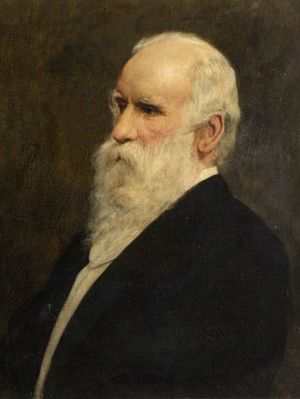Robert Stirling Newall facts for kids
Quick facts for kids
Robert Stirling Newall
|
|
|---|---|

R.S. Newall
|
|
| Born | 27 May 1812 Dundee, Scotland
|
| Died | 21 April 1889 (aged 76) Gateshead, England
|
| Nationality | Scottish |
| Known for | Submarine telegraph cable |
Robert Stirling Newall (born May 27, 1812 – died April 21, 1889) was a clever Scottish engineer and astronomer. He was known for his important work with telegraph cables and for building a very large telescope. He was also a member of the Royal Society and the Royal Astronomical Society, which are groups for important scientists.
Contents
Early Life and Work
Robert Stirling Newall was born in Dundee, Scotland, on May 27, 1812. He started his career working in a local business office. Later, he moved to London and worked with Robert McCalmont. There, he experimented with making steam very quickly. He also spent two years in America, helping to grow McCalmont's business.
Inventing Wire Ropes
In 1838, a friend named L.D.B. Gordon was studying in Germany. He visited some mines and saw how strong wire ropes were. Gordon wrote to Robert Newall, telling him to "Invent a machine for making wire ropes."
Newall took on the challenge! He designed a machine that could make strong wire ropes. These ropes were made from four strands, with four wires in each strand. When Gordon returned to the UK in 1839, he teamed up with Newall and Charles Liddell. They started a company called R.S. Newall and Company in Dundee. On August 17, 1840, Newall received a patent for his new wire rope machine. This meant his invention was officially protected.
Building Submarine Cables
R.S. Newall and Company opened a factory in Gateshead, England. They began making wire ropes for many uses, like mining, railways, and ships. But Newall's biggest impact was on telegraph cables that went under the sea.
New Cable Design
Newall greatly improved how submarine telegraph cables were made. He came up with a method using a material called gutta percha around the wires. This was then covered with strong metal wires for protection.
His factory made the first successful cable laid between Dover, England, and Calais, France. This important cable was put down on September 25, 1851. Newall's company continued to make many more cables. In 1853, he invented a special 'brake-drum' and cone. These tools helped lay cables safely in very deep parts of the ocean.
Laying Cables Around the World
Because laying these cables was so difficult, Newall often personally supervised the process. He helped lay many important cables, including:
- From Holyhead to Howth
- From Dover to Ostend
- From Malta to Corfu
- Several others in the Mediterranean Sea
- From Suez to Aden
- From Aden to Kurrachee
- From Constantinople and Varna to Balaclava in 1855
His factory even made half of the very first Atlantic cable. This cable connected Europe and North America! The last submarine cable Newall personally laid was in 1868. It connected Ringkjobing in Denmark with Newbiggen, Northumberland, England.
Passion for Astronomy
Newall was also very interested in astronomy, which is the study of stars and planets. He had a private observatory at his home in Gateshead, called Ferndene.
The Newall Telescope
He asked a famous telescope maker, Thomas Cooke, to build a special telescope for him. For many years, this 25-inch refracting telescope was the largest in the world! After Newall died in 1889, the telescope was given to the Cambridge Observatory.
By the late 1950s, the telescope was not being used much. So, in 1958, it was donated to the National Observatory of Athens in Greece. It was then placed at the Penteli Astronomical Station, just north of the city of Athens.
Awards and Family
Newall received many honors for his work. He became a member of the Royal Astronomical Society in 1864. In 1875, he became a member of the Royal Society, a very old and respected group of scientists. He also joined the Institute of Mechanical Engineers in 1879.
In 1872, he was given the Order of the Rose of Brazil, a special award from Brazil. The University of Durham also gave him an honorary degree in 1887.
On February 14, 1849, Newall married Mary Pattinson. She was the youngest daughter of Hugh Lee Pattinson, who was also a member of the Royal Society. Robert and Mary had four sons and one daughter. One of their sons, Hugh Newall, also became a famous scientist and a member of the Royal Society.
Robert Stirling Newall passed away at his home, Ferndene, on April 21, 1889.

